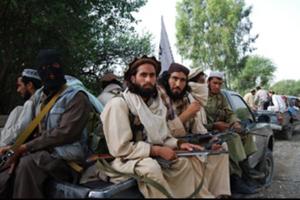TerrorismU.S. losing patience with Pakistan over Haqqani network’s growing boldness
Last week the Pakistan government-supported Haqqani network released a video of a 1 June operation, showing members of the group driving an explosive-laden truck into Camp Salerno, an American military base in Afghanistan, near the Pakistani border; the truck exploded, opening a breach in the camp’s fence, through which Haqqani militants entered the camp, shooting in all directions; only two GIs died in the attack — but it could have been far worse, as hundreds of American soldiers were in the mess hall only yards away; Congress has already voted to designate the Haqqanis as a Foreign Terrorist Organization (FTO), and administration officials say that the United States is “one major attack” away from unilateral action against Pakistan

Haqqani fighters // Source: presstv.ir
Last week the Haqqani network released a video of a 1 June operation, showing members of the group driving an explosive-laden truck into Camp Salerno, an American military base in Afghanistan, near the Pakistani border. The truck exploded, opening a breach in the camp’s fence, through which Haqqani militants entered the camp, shooting in all directions.
What was wrong with this picture? The Haqqani network was a tribal militia of a few thousand men which, in the 1990s, was engaged in the traditional activity of tribes along the Pakistan-Afghan border: Mafia-like criminal activity which included smuggling, drugs, extortion, and the like.
Following the 2001 U.S. toppling of the Taliban government in Afghanistan, the Pakistani military’s Inter-Services Intelligence (ISI) struck a deal with the Haqqanis: the Pakistani government will turn a blind eye to the group’s criminal activity, and in return the Haqqanis would use their knowledge of the terrain and its people, and the groups considerable military capabilities, to frustrate the U.S. strategy in Afghanistan.
The Haqqanis, now armed with Pakistan military-supplied weapons and equipment and intelligence provided by the ISI, have launched a broad campaign to destabilize the Karzai government, kill Afghani security and military personnel, and help the Taliban regain a foothold in south Afghanistan.
Pakistan receives billions of dollars in military and economic aid from the United States every year, but those did not prevent the ISI to help the Haqqani kill American soldiers by sniper fire, IEDs, or spectacular suicide attacks like the one at Camp Salerno.
The Pakistani government officially denies any operational involvement with the Haqqani network, but the United States is losing its patience with Pakistan’s lies – and with the increased tempo and effectiveness of the Haqqani operations, both, U.S. officials say, the result of growing Pakistani logistical, intelligence, and operational assistance to the group.
On 17 July the U.S. House of Representative yesterday voted to designate the Haqqani Network as Foreign Terrorist Organization (FTO). The Senate voted on a similar resolution a few days later. The administration, desperate to find a way to maintain the strategic cooperation with other elements in the Pakistani government, has been more measured in its public utterances, if not in its private demarches to its Pakistani interlocutors, but the growing boldness of the Haqqanis has eroded the administration’s patience.
The New York Times reports today that
the new boldness from the Haqqanis that aims at mass American casualties, combined with simmering political tension, has reduced the room for ambiguity between the two countries [the United States and Pakistan]. Inside the administration, it is a commonly held view that the United States is “one major attack” away from unilateral action against Pakistan — diplomatically or perhaps even militarily, one senior official said.
“If 50 U.S. troops were blown to smithereens by the Haqqanis, or they penetrated the U.S. Embassy in Kabul and killed several diplomats — that would be the game changer,” he said.
The Haqqanis’ 1 June Camp Salerno attack failed: although the explosives truck breached the camp’s perimeter fences, the Haqqani militants who followed, spraying bullets from their weapons, were killed quickly by U.S. soldiers. Only two American GIs died in the attack – but it could have been much worse: there were hundreds of soldiers in the mess hall at the time of the attack, and if the Haqqanis had managed o reach it – it was located only yards away from where the fence was breached, just the kind of information the Pakistani ISI would supply the Haqqanis — the toll would likely have been much higher.
In the days following the Camp Salerno attack, senior U.S. national security and military officials held a series of meetings, which, the New York Times reports, yielded a list of about thirty possible responses — everything from withdrawing the Islamabad ambassador, to a flurry of intensified drone attacks on Haqqani targets in Pakistan’s tribal belt, to American or Afghan commando raids on Haqqani hide-outs in the same area.
“We looked at the A to Z of how to get the Pakistanis’ attention,” the official told the Times, speaking on the condition of anonymity, as did other American and Pakistani officials interviewed about the issue.
The Times reports that following the Camp Salerno attack, the Pakistani army chief, Ashfaq Parvez Kayani, privately told American officials that the Pakistani army would launch a 3-phase military operation against the Haqqanis over the coming twelve months. “Most American officials, however, say they are not counting on that promise,” The Times writes. “One remarked with a sardonic touch, ‘This is the most delayed campaign in the history of modern warfare.’”
